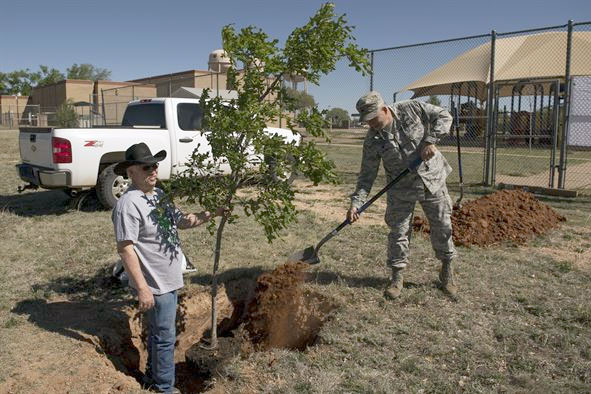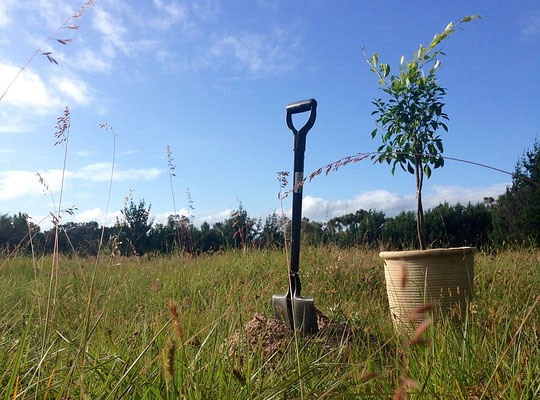Only bury your tree after it’s dead

These airmen have dug a “fifty-dollar hole,” but it’s likely to become the tree’s grave if they don’t raise the trunk flare up to surface level. U.S. Air Force photo by Staff Sgt. Michael Washburn
In springtime, driving around on weekends makes me sad. Invariably I’ll pass someone out in their yard, shovel in hand, maybe with their kids or spouse, and they have a cute little tree from the garden center on one side of them, and a wicked deep hole in the ground on the other. If I wasn’t so shy, I’d stop and offer my condolences, because clearly they are having a funeral for the tree.
Here’s an arborist joke: What do you call a three-foot deep planting hole for a tree? Its grave. Tree root systems are broad—three times the branch length, barring an impediment—and shallow. Ninety percent of tree roots are in the top ten inches of soil, and 98% are in the top eighteen inches. Tree roots are shallow because they like to breathe on a regular basis. I think we can all relate to that.
Soil pores allow roots to get oxygen, which ultimately comes from the soil surface. Oxygen levels drop with soil depth, ultimately reaching zero at some point. In silty, clay or loam soils, that point is less than three feet down. To make matters worse, adding compost or manure to a deep planting hole ensures the roots will suffocate, because the microbes that break down organic matter will use up all available oxygen.
Every tree comes with planting instructions, even if there is no tag. To read these directions, find the spot near the base where the trunk widens out and the roots begin. This is called the trunk flare, and is the depth gauge. The trunk flare should be just visible at the soil surface. With a very small specimen, especially a small grafted tree, this can be tricky. Basically find the uppermost root and park it about an inch below the surface.
Not all trees planted too deeply die, but they all suffer a lot, and even in the best cases, it will take them years to catch up with a similar tree planted correctly. In general, smaller trees fare better than larger ones. Sometimes a little tree can survive by sending out fibrous (adventitious) roots from its stem just below the soil surface. Larger trees do this too, but the scrawny new roots will not support a large top.
Occasionally you may come across planting instructions that suggest a deep hole, but you can literally search the world over, and you will never hear such nonsense from a research-based source. Get your trees from a garden center, but your planting advice from an evidence-based institution.
There is an old saying, “dig a fifty-dollar hole for a five-dollar tree.” It may need to be adjusted for inflation but the idea still has currency. The planting hole should be saucer-shaped and 2-3 times the diameter of the root system, but no deeper—ever. Otherwise the Planting Police will ticket you. Not really, but if an arborist happens to come along, they may scowl ominously at you.

When planting a container-grown tree, be sure to remove all burlap and twine, and straighten out any encircling roots as they may girdle the tree as it grows. Photo: Juan Pienaar
Before backfilling, remove all burlap and twine. Wire cages on ball-and-burlap trees should be cut away once the tree is positioned in the hole. Container-grown tree root systems may have circling roots that must be teased out straight, or they will become girdling roots years later and choke the trunk.
Adding loads of organic matter to the backfill likely dates back to ancient times, when folks might grab an arborist, if one was handy, and throw them in the planting hole. Possibly in response to this, arborists now recommend little or no additional organic matter in many cases.
In very sandy or heavy clay soils, moderate (up to 30%) amounts of peat moss, compost or other amendments can be used in the backfill. Do not add sand to clay, though—that is how bricks are made, and most plants do not grow real well in bricks. Adding more organic matter than one-third by volume can cause a “teacup effect,” and roots could suffocate. Fertilizer is stressful on new transplants, so wait at least a year on that. In healthy native soils, a tree may never need commercial fertilizer.
Water thoroughly as you backfill, and prod the soil with a stick or shovel handle to eliminate air pockets. Unless the site is very windy it’s best not to stake the tree—movement is needed for a strong trunk to develop. Two to four inches of mulch over the planting area (but not touching the trunk) will help conserve moisture and suppress weeds. It’s almost impossible to over-water a new transplant, but it does happen. Throughout the first season, check the soil every few days to be sure it’s moist but not waterlogged.
Have fun landscaping, but please wait until after your tree dies to inter it.
Paul Hetzler is a horticulture and natural resources educator with Cornell Cooperative Extension of St. Lawrence County.







